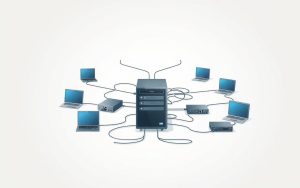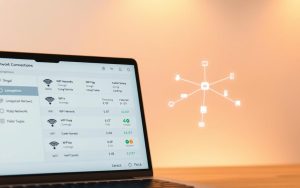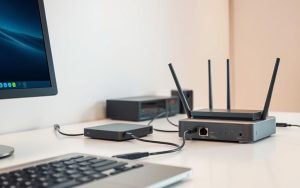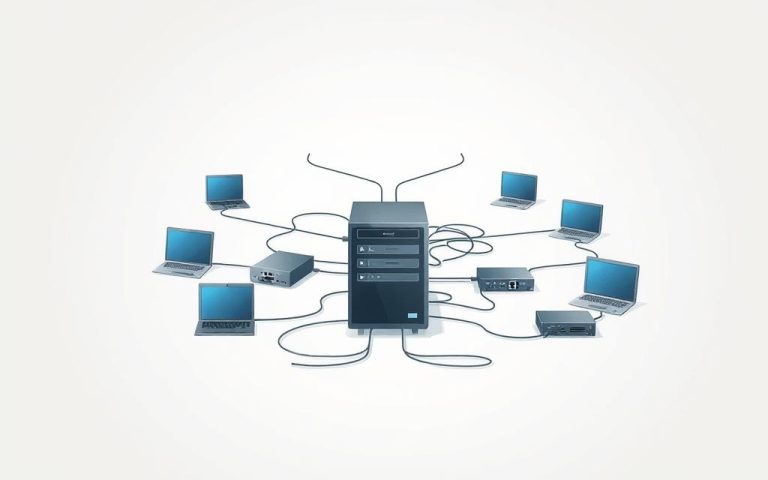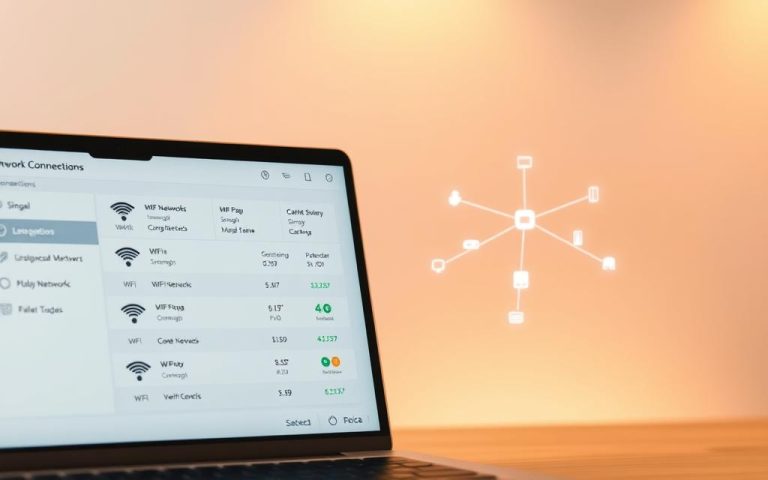What Are Nodes in a Computer Network? Explained
Modern digital communication relies on connection points called network nodes. These elements serve as critical links, allowing devices to exchange data efficiently. From smartphones to routers, each plays a unique role in keeping networks functional.
Connection points can be physical hardware like printers or logical representations in software. They direct traffic, store information, and enable seamless interactions across systems. This foundation supports everyday tech, from video streaming to cloud services.
Originally rooted in distributed systems, these components evolved with packet-switching technology. Today, they power IoT ecosystems and enterprise solutions, proving indispensable in our connected world.
What Is Nodes in Computer Network?
Every connected device in a digital ecosystem acts as a communication hub. These elements, equipped with network interfaces (NICs) and unique identifiers like IP addresses, form the backbone of data exchange.
Core Capabilities
These hubs perform three critical tasks:
- Recognize incoming data packets
- Process information based on protocols (TCP/IP, HTTP)
- Forward transmissions to their next destination
“Governed by protocols, nodes ensure reliable data delivery across networks.”
Driving Seamless Interactions
Routers direct traffic between local and wide-area networks, while switches manage internal connections. Simple file transfers between laptops differ from server clusters exchanging terabytes—yet both rely on these interconnected points.
Automated discovery tools map these components dynamically, ensuring efficient routing paths. This protocol-driven synergy keeps emails, videos, and cloud services running smoothly.
Key Functions of Network Nodes
Critical functions enable smooth communication across systems. These components handle everything from routing traffic to enforcing security policies, ensuring reliable performance for users and devices.
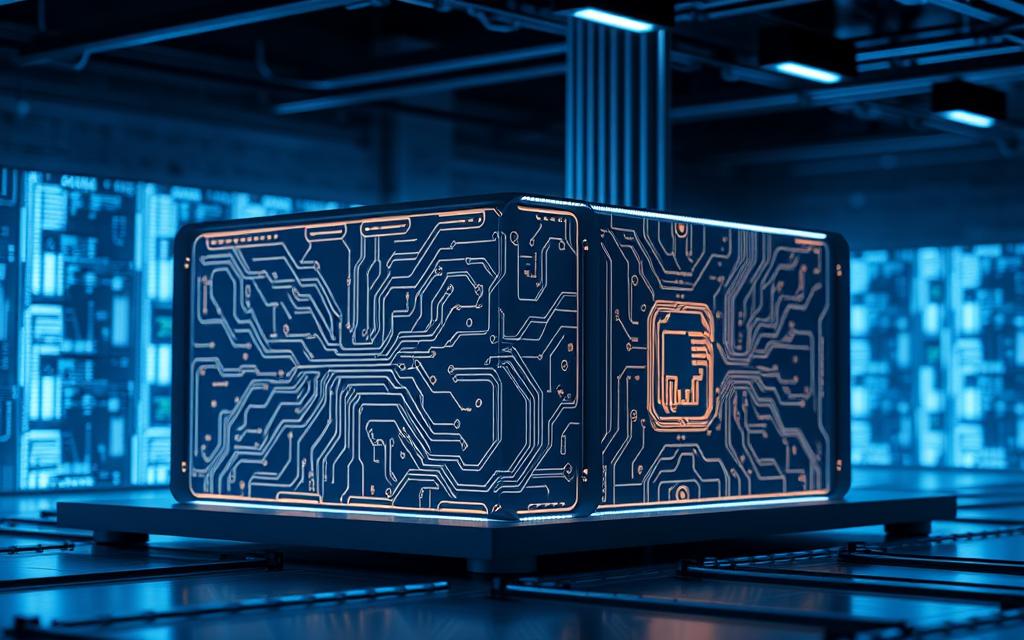
Data Transmission and Redistribution
Packet switching breaks information into smaller units for efficient routing. Each unit travels independently, reassembling at its destination.
Modern systems prioritize traffic using Quality of Service (QoS) settings. Video calls or cloud backups get bandwidth priority over less urgent tasks.
Resource Sharing and Access Control
A print server manages multiple users accessing a single printer. Role-based rules determine who can print, edit, or delete jobs.
| Access Level | Permissions |
|---|---|
| Admin | Add/remove users, configure settings |
| Standard User | Submit print jobs, view queue |
Security and Authentication
TLS 1.3 encrypts data between devices, preventing interception. Zero-trust models verify every request, even from familiar sources.
“Firewalls and ACLs filter unauthorized traffic, creating layered defenses.”
Types of Network Nodes
Digital ecosystems thrive on diverse connection points with distinct roles. These elements range from user-facing devices to behind-the-scenes traffic managers, each optimized for specific tasks.
End Nodes vs. Intermediate Nodes
End devices like printers and computers interact directly with users. Classified as Data Terminal Equipment (DTE), they send or receive data but rarely route traffic.
In contrast, intermediate hubs—routers, switches—act as traffic directors. These Data Circuit-Terminating Equipment (DCE) devices ensure packets reach their destinations efficiently.
| Node Type | Role | Examples |
|---|---|---|
| End (DTE) | User interaction | Printers, PLCs, smartphones |
| Intermediate (DCE) | Traffic management | Bridges, switches, modems |
Physical vs. Logical Nodes
Tangible hardware—routers, servers—fall under physical categories. These units occupy physical space and handle direct connections.
Logical constructs like VLANs exist in software. They segment networks virtually, enabling flexible configurations without rewiring.
“Virtual segmentation through logical nodes reduces hardware costs while boosting scalability.”
Bridges exemplify hybrid roles, connecting disparate segments like wired and wireless networks. Industrial systems rely on specialized end nodes such as PLCs, while embedded systems power IoT devices with minimal overhead.
Common Examples of Network Nodes
From home gadgets to industrial systems, connection points power modern communication. These elements vary widely, adapting to needs like streaming movies or managing city traffic.
Devices Like Computers and Printers
Consumer tech relies on everyday *devices* with network capabilities:
- Smart TVs and gaming consoles stream content via Wi-Fi
- NAS drives centralize files for home or office networks
- Printers with cloud connectivity enable remote job submissions
Infrastructure Nodes: Routers and Switches
Enterprise environments depend on robust traffic managers:
- Cisco Catalyst switches optimize internal data flow
- Juniper routers direct WAN traffic across continents
“IBM’s Weather Company uses mesh nodes to process global climate data in real time.”
IoT and Edge Nodes
Emerging tech pushes boundaries with specialized hubs:
- Autonomous vehicles use edge computing for instant decisions
- Smart cities deploy sensor *nodes* in traffic lights for adaptive control
- AWS Snowball *edge* devices migrate petabytes offline
| Node Type | Use Case |
|---|---|
| LoRaWAN *IoT* | Low-power sensors (agriculture, utilities) |
| Edge *server* | Real-time video analytics (retail, security) |
How Nodes Are Identified in a Network
Digital ecosystems require precise identification methods for all connected components. Unique addressing ensures seamless communication between devices, whether they’re across the room or continents apart.
IP Addresses and MAC Addresses
Two fundamental identifiers govern modern networks:
- IPv4 addresses (32-bit) like 192.168.1.1
- IPv6 addresses (128-bit) for expanded capacity
The Address Resolution Protocol (ARP) bridges these with hardware-level MAC addresses. This 48-bit identifier (e.g., 00:1A:2B:3C:4D:5E) remains burned into network interface cards.

Persistent identifiers like server IPs contrast with ephemeral DHCP assignments. Mobile devices now use randomized MAC addresses for privacy, complicating traditional monitoring approaches.
Node Discovery Tools
Automated solutions map network components visually:
| Tool | Strength |
|---|---|
| SolarWinds | Enterprise-scale topology mapping |
| PRTG | Real-time traffic analysis |
Packet sniffers like Wireshark decode transmission details. These node discovery tools reveal connection patterns and potential bottlenecks.
“Modern networks require dynamic identification systems to handle BYOD and IoT proliferation.”
Advanced systems now combine AI with traditional ping sweeps. This hybrid approach maintains accuracy despite randomized identifiers in iOS/Android devices.
Network Nodes by Topology
Different network layouts shape how devices communicate efficiently. The arrangement of connection points—whether star, bus, or mesh—determines speed, reliability, and scalability. Enterprises choose configurations based on needs like fault tolerance or cost-effectiveness.
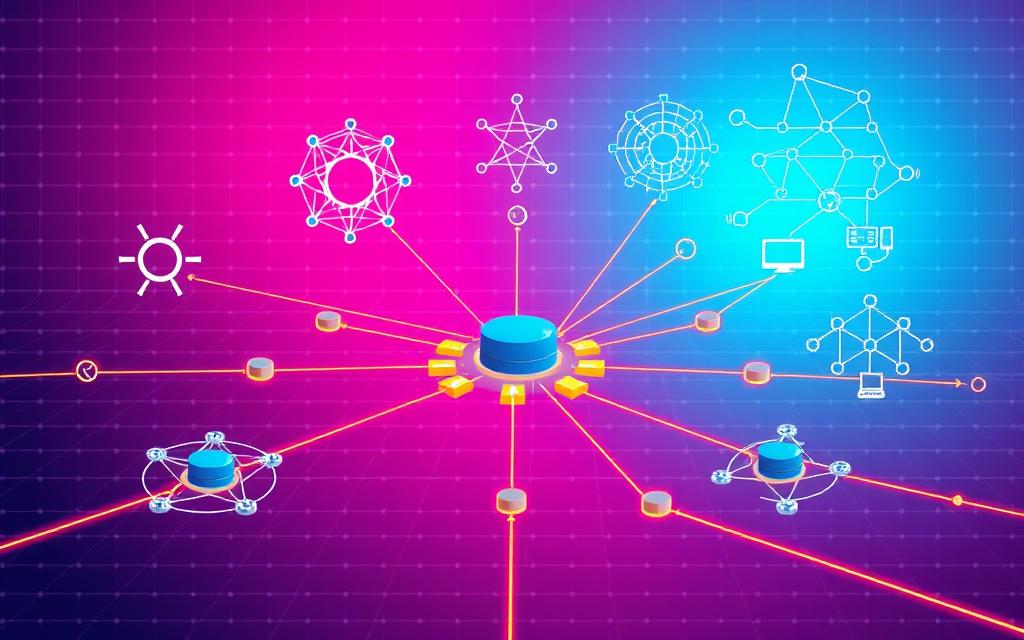
Star, Bus, and Ring Topologies
Star setups centralize traffic through a hub, like office Wi-Fi routers. If the hub fails, the entire network stalls. However, adding new devices is simple—just connect to the central point.
Bus systems, used in cable broadband, link devices to a single backbone cable. Collisions increase as more nodes join, slowing performance. AT&T’s fiber-optic ring topology avoids this by circulating data clockwise, ensuring redundancy if one link breaks.
Mesh and Hybrid Networks
Mesh configurations, such as IBM’s outage-resistant design, route data through multiple paths. Each node connects to others, eliminating single points of failure. This suits critical systems like emergency services.
- Hybrid models blend topologies for flexibility. A university might combine star (dorms) and ring (research labs).
- SDN dynamically adjusts connections, optimizing traffic in real time.
- 5G slicing creates virtual networks on shared hardware, enabling customized topologies for different services.
“AT&T’s hybrid fiber-ring design reduced downtown Chicago’s network downtime by 40%.”
| Topology | Max Nodes | Fault Tolerance |
|---|---|---|
| Star | 250+ | Low (hub-dependent) |
| Mesh | Unlimited | High (multiple paths) |
Nodes in Different Network Types
Connection points adapt to various digital environments, from small offices to global infrastructures. Their roles shift based on scale, purpose, and technology, ensuring seamless communication across diverse setups.
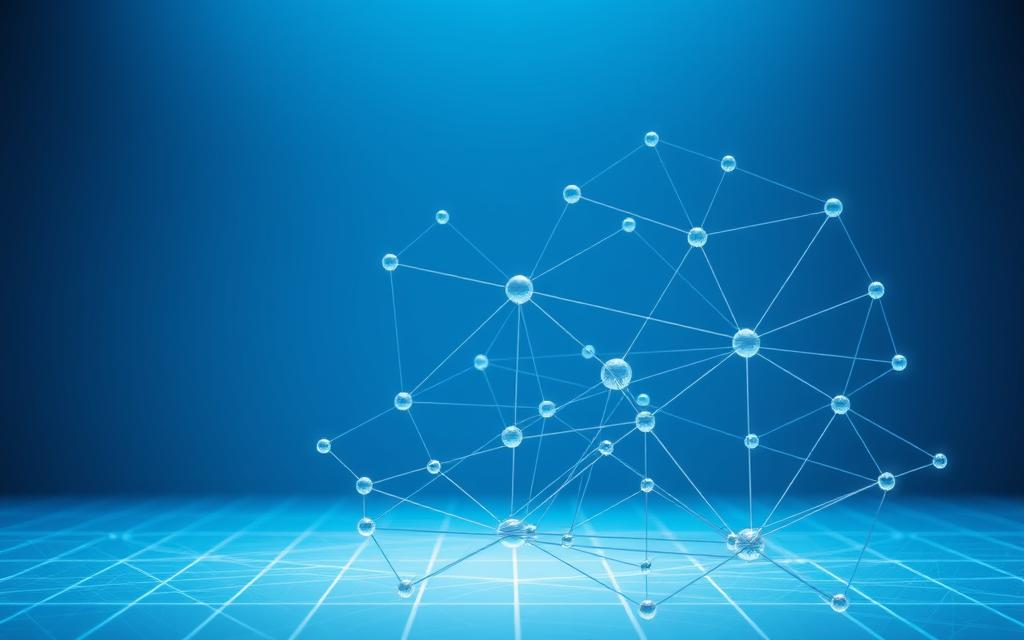
LANs and WANs
Local Area Networks (LANs) concentrate devices within limited spaces like offices. Printers, desktops, and NAS drives connect through switches, with typical node counts under 100. These setups prioritize low latency and high-speed data transfers.
Wide Area Networks (WANs) span continents, linking ISPs and enterprises. Core routers like Cisco ASR 9000 handle millions of packets per second. Unlike LANs, WANs use MPLS for efficient traffic routing across carrier-grade backbones.
| Feature | LAN | WAN |
|---|---|---|
| Node Density | High (devices per sq. ft.) | Low (strategic placement) |
| Latency | <1ms | 50-300ms |
| Protocols | Ethernet, Wi-Fi | MPLS, BGP |
Telecommunications and Internet Networks
Cellular systems rely on specialized connection points. 5G eNodeB components manage radio access, while base station controllers optimize signal distribution. These elements form hierarchical structures, balancing load across regions.
The internet operates as interconnected autonomous systems. Tier 1 exchange points like DE-CIX Frankfurt route 9+ terabits daily. Submarine cable landing stations act as critical junctures, linking continents through fiber-optic backbones.
- Starlink’s satellite constellation uses 3,000+ low-orbit nodes
- Google’s private backbone employs 400+ global points of presence
- AT&T’s backbone processes 300 petabytes daily through 12 core nodes
“Modern telecom networks blend physical and virtual nodes, enabling services from VoIP to IoT at scale.”
Real-World Applications of Network Nodes
Across industries, interconnected systems transform operations through strategic connection points. These components enable everything from hospital monitoring to global content delivery, proving their versatility in modern infrastructure.
Enterprise Printing Systems
Corporate environments rely on centralized print management. A single enterprise printer serves dozens of users, queuing jobs via IP-based protocols. Cloud-integrated models now allow remote submissions from any location.
Access controls ensure security—admins configure permissions, while employees submit jobs. For example, law firms use encrypted queues to protect sensitive documents. This streamlined approach reduces hardware costs and IT overhead.
Cellular Networks and Base Stations
Mobile carriers depend on base stations to route calls and data. Controllers like BSCs balance traffic across towers, while Gateway GPRS Support Nodes (GGSNs) link cellular and internet systems.
5G deployments use small cells to boost urban coverage. These low-power units fit on lampposts, creating dense grids for faster speeds. Rural areas benefit from macro stations with 20-mile ranges.
Peer-to-Peer and IoT Networks
Blockchain networks like Bitcoin rely on peer-to-peer validation. Each participant maintains a copy of the ledger, ensuring transparency without central servers.
In healthcare, IoT sensors track patient vitals and alert staff to anomalies. Smart grid applications use similar tech to monitor power lines, rerouting electricity during outages.
“Amazon Sidewalk’s shared bandwidth model demonstrates how community nodes can enhance coverage without costly infrastructure.”
Military teams deploy tactical edge systems for battlefield communications. These ruggedized units operate offline, relaying data via mesh configurations when satellites are unavailable.
Challenges in Managing Network Nodes
Effective network operations face growing complexities as connection points multiply. Hybrid workforces and IoT expansion strain traditional management frameworks, requiring adaptive solutions for performance and security.
Performance Monitoring Hurdles
BYOD policies create node sprawl, with personal devices accessing corporate systems. Legacy protocols like SNMP struggle with real-time metrics, while NETCONF offers programmability but demands expertise.
AIOps platforms now predict failures using machine learning. These tools analyze traffic patterns, automatically rerouting data before bottlenecks occur.
| Protocol | Best For | Limitations |
|---|---|---|
| SNMPv3 | Basic device stats | No configuration management |
| NETCONF | Automated changes | Complex YANG modeling |
Security Risks and Mitigations
Unpatched IoT devices expose networks to risks like Mirai botnets. Zero-day exploits target firmware vulnerabilities, bypassing traditional firewalls.
- CIS Benchmarks: Hardening guides for routers/switches
- Ephemeral certificates for device authentication
- Microsegmentation to contain breaches
“Gartner predicts 30% of enterprises will adopt AI-driven node management by 2025, reducing outage times by 50%.”
Encrypted tunnels (WireGuard, IPsec) protect data in transit. Regular audits ensure compliance with frameworks like NIST 800-53, addressing lifecycle challenges from deployment to decommissioning.
Conclusion
Efficient data transmission hinges on well-managed network nodes, from physical hardware to application-layer logic. These components adapt to diverse topologies, ensuring reliability in star, mesh, or hybrid setups.
Edge computing reshapes architectures, decentralizing processing power. This shift demands robust security measures, as expanded attack surfaces require encrypted protocols and zero-trust models.
Proactive monitoring tools—like AI-driven analytics—simplify complex environments. Regular audits and topology-specific strategies future-proof systems against evolving threats.
Prioritize scalable solutions to maintain seamless operations. Invest in adaptive frameworks that balance performance with protection, ensuring long-term resilience.




